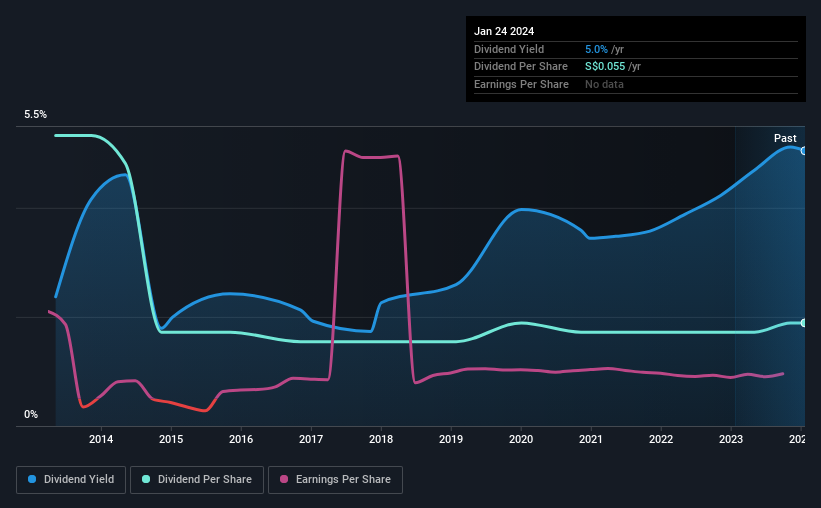Fraser and Neave (SGX:F99) Is Increasing Its Dividend To SGD0.04
Fraser and Neave, Limited (SGX:F99) has announced that it will be increasing its periodic dividend on the 16th of February to SGD0.04, which will be 14% higher than last year's comparable payment amount of SGD0.035. This takes the annual payment to 5.0% of the current stock price, which is about average for the industry.
Check out our latest analysis for Fraser and Neave
Fraser and Neave's Dividend Is Well Covered By Earnings
Solid dividend yields are great, but they only really help us if the payment is sustainable. The last dividend was quite easily covered by Fraser and Neave's earnings. This means that a large portion of its earnings are being retained to grow the business.
If the trend of the last few years continues, EPS will grow by 1.4% over the next 12 months. If the dividend continues along recent trends, we estimate the payout ratio will be 52%, which is in the range that makes us comfortable with the sustainability of the dividend.
Dividend Volatility
While the company has been paying a dividend for a long time, it has cut the dividend at least once in the last 10 years. Since 2014, the dividend has gone from SGD0.155 total annually to SGD0.055. The dividend has shrunk at around 9.8% a year during that period. A company that decreases its dividend over time generally isn't what we are looking for.
The Dividend's Growth Prospects Are Limited
Given that the track record hasn't been stellar, we really want to see earnings per share growing over time. However, Fraser and Neave's EPS was effectively flat over the past five years, which could stop the company from paying more every year. Growth of 1.4% per annum is not particularly high, which might explain why the company is paying out a higher proportion of earnings. While this isn't necessarily a negative, it definitely signals that dividend growth could be constrained in the future unless earnings start to pick up again.
In Summary
Overall, this is a reasonable dividend, and it being raised is an added bonus. While the payout ratios are a good sign, we are less enthusiastic about the company's dividend record. The dividend looks okay, but there have been some issues in the past, so we would be a little bit cautious.
Market movements attest to how highly valued a consistent dividend policy is compared to one which is more unpredictable. At the same time, there are other factors our readers should be conscious of before pouring capital into a stock. To that end, Fraser and Neave has 2 warning signs (and 1 which is a bit unpleasant) we think you should know about. If you are a dividend investor, you might also want to look at our curated list of high yield dividend stocks.
Have feedback on this article? Concerned about the content? Get in touch with us directly. Alternatively, email editorial-team (at) simplywallst.com.
This article by Simply Wall St is general in nature. We provide commentary based on historical data and analyst forecasts only using an unbiased methodology and our articles are not intended to be financial advice. It does not constitute a recommendation to buy or sell any stock, and does not take account of your objectives, or your financial situation. We aim to bring you long-term focused analysis driven by fundamental data. Note that our analysis may not factor in the latest price-sensitive company announcements or qualitative material. Simply Wall St has no position in any stocks mentioned.

 Yahoo Finance
Yahoo Finance 
